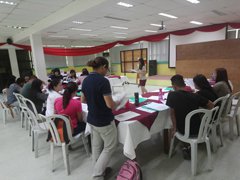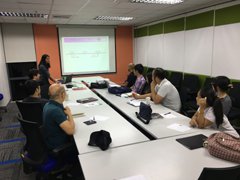Supporting Japanese-language Education in the Visayas Region
The Japan Foundation, Manila (Cebu)
SHINTANI Chika
Course on Japan for High School Classroom Instructions (CJH) in Cebu Celebrates its Third Year
The teacher’s program of the “Course on Japan for High School Classroom Instructions (CJH)” began from fiscal 2009, but in addition to the Manila venue, for the program’s fourth batch, from fiscal 2016, training began at a Cebu venue. This training program comprises a five-week summer intensive training program held in April and May, and a monthly follow-through training program (10 sessions in total). It is implemented across a three-year period. In the third year the summer intensive training program includes a 10-day training visit to Japan. During the training participants learn the Philippine’s high school Japanese-language educational teaching material, “enTree ‐ Halina! Be a NIHONGOJIN!! ‐,” from a student’s perspective and a teacher’s perspective. In addition, they take classes designed to enhance Japanese-language skills using “Marugoto Starter (A1)” and “Marugoto Elementary 1 (A2)” of “Marugoto Katsudo” and classes on teaching methods where they learn about 21st Century-type skills and evaluation methods.

A practice lesson using “enTree”
At the Cebu venue, there are currently a total of 17 teachers from nine schools taking part, drawn from the Cebu Island and Bohol Island area. They are teachers of various subjects, including English, Filipino, science, humanities and physical education, but because they are relatively young – many are in their 20s – each training session is held in a very lively and enjoyable atmosphere. For some of the teachers it takes three hours or more to travel from their homes to the training venue, so participating in the monthly training sessions is no easy task for the teachers. However, the friendly personal relationships that the teachers share help to support attendance at the training. The program is now in its third year, and the team strength is such that it is hard to believe the teachers are from different schools and teach different subjects. They have designed matching polo shirts, get together of their own accord to hold study sessions ahead of the Japanese-Language Proficiency Test (hereinafter “JLPT”), and are studying toward a common goal while helping each other out.
The Department of Education is currently working on creating a new curriculum for Japanese-language education in Philippine high schools, which will mean the teachers will require a higher level of Japanese-language ability in the future. Even in the Department of Education, having the JLPT is considered an indicator of Japanese-language skills, and Japanese-language teachers are enthusiastically engaged in Japanese-language learning, toward passing the JLPT. In the December JLPT last year, five teachers from the Cebu venue passed the N5 level. The fourth batch of participants is working hard with the aim of all passing N5 this fiscal year.
Benkyoukai of ANT-V (the Association of Nihongo Teachers in the Visayas)

Cebu’s Japanese-language teachers come together each month to hold study groups
ANT-V (the Association of Nihongo Teachers in the Visayas) was launched in 2008, making this year its 10th year. It is an organization mainly made up of Philippine Japanese-language teachers, and in fiscal 2017 it began activities under new management. ANT-V borrows an office at a Japanese company once a month to hold “benkyoukai” (study groups). At these study groups, a person is nominated each month to present a lecture. These lectures cover a wide range of topics, from lectures relating to Japanese-language education, such as syllabuses and teaching methods, to thoughts on the grammar of the Japanese language known as the Japanese-Language Level Up Series, to lectures introducing Shogi (Japanese chess) and other aspects of Japanese culture. Participation is not compulsory, and everything is left up to autonomous efforts, but the larger study groups attract around 15 teachers. Several ANT-V members are involved in secondary school Japanese-language teacher training as instructors, and ANT-V also serves to connect them with high-school teachers in the Visayas region. ANT-V is actively involved in activities other than the study groups also, including holding a conference on Japanese-language education in the Cebu region and overseeing a Karaoke contest held as part of the Bon Festival dance competition held in Cebu. The association is composed of members who will take a leading role in the future of Japanese-language education in the Visayas region, and they are undertaking their activities energetically.
- What We Do Top
- Arts and Cultural Exchange [Culture]
- Japanese-Language Education Overseas [Language]
- Japanese-Language Education Overseas [Language] Top
- Learn Japanese-language
- Teach Japanese-language
- Take Japanese-Language Test
- Know about Japanese-language education abroad
- The Japanese-Language Institute, Urawa
- The Japanese-Language Institute, Kansai
- Japanese-Language Programs for Foreign Specified Skilled Worker Candidates
- Japanese Language Education for Japanese Children Resident Overseas and for the Descendants of Migrants
- Archives
- Japanese Studies and Global Partnerships [Dialogue]
- JF digital collection
- Other Programs / Programs to Commemorate Exchange Year
- Awards and Prizes
- Publications
